War Bonnets
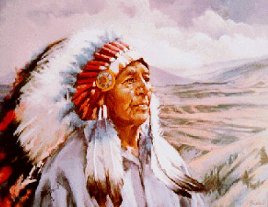
- The "war bonnet" arose from the Sioux or Crow tribes on the plains of North America, and rapidly spread to other tribesmen. This bonnet, said to be symbolic of the sun and its spreading rays was quite uncommon originally and could only be worn by the bravest warriors. As the tradition spread, bonnets capped every Plains tribe's bravest warriors. Thanks to the glamorizing of the Sioux, every important Native American in modern times is expected to own and wear a war bonnet.
Local birds such as yellow-headed blackbirds, turkeys, ducks, flickers, woodpeckers, road runners, and scissortails were the sources of a bonnet's plumage before the introduction of colorful modern dyes. Each part of the preparation of a single feather might have significance. The killing of any enemy was indicated in one tribe by horsehair tips. Among the Crees, it was shown the wearer had wrestled and overcome an enemy by the removal of web from most of the quill. The signature of the bonnet maker is indicated by the major plume in the back of the bonnet which marked the sign of individiual achievement. Distinguished warriors who performed many exploits were so honored by attaching strips of rabbit fur or ermine with pieces of cloth hanging down.
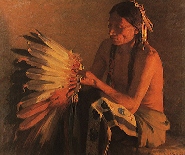
Peace Pipe
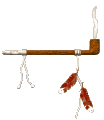
- Before selfishness crept into the
world - that was a long time ago - The Cherokee people were happy and
peaceable. They used the same hunting grounds and fishing grounds as
their neighbors. They fished in the same streams and hunted in the
same stands of forest. There were no arguments about boundaries and
there were no arguments about fishing rights. But this was before Men
became greedy. All this changed when Men learned to quarrel.
The first quarrel that arose was between the Cherokee and a neighboring tribe. It was a long and bitter quarrel, so bitter that the chiefs of the two tribes decided to meet in council to try and settle their trouble. And so they met, one day, and they smoked the peace pipe in solemn council, but they did not stop quarreling. A puff on the peace pipe and a bitter word was the way it went. Days passed and still the council sat and smoked and quarreled.
Now the Great Spirit was much displeased that the Indians should quarrel while smoking the pipe of peace. And the Great Spirit said, "I shall have to do something to you men that will show you that People should live together in peace, and that when Indians smoke the pipe, it must be done in peace."
The Great Spirit looked down at the old Men sitting in all that smoke. And he saw how gray they looked and how their heads hung down in weariness because it had been many nights since they had slept. And so he turned the old Men who smoked there in the council into small silvery gray flowers, their heads bent over and their petals hoary.
If you should find one in the woods and turn it so that the head is down and the stem up, you will see that it looks like an Indian pipe, and so it is called to this day. But in the woods where they are often seen clustered together, they appear to be little gray People sitting in long council.
Now after the Great Spirit had changed the quarreling Indians into flowers and set them out in the forest, he noticed that the smoke from their pipes still hung heavy in the air above the place where the council had been. So he gathered up the smoke and draped it over the mountains as a reminder. And he left it there until such time as all Men shall learn to live peace together.
A message or prayer may be sent by offering some tobacco or a similar mixture of plants and tree barks during ceremonial times. The blend of plants and tree barks that I use is called Kinnick Kinnick. It contains Mugwort, Mullin, Angelica, Spearmint, Bear Berry, Red Willow, Osha Root, Sage and Tobacco. Hallucinogens are strictly forbidden in the use of the pipe.
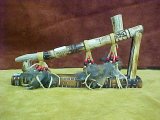
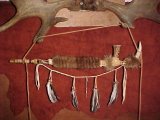
The Medicine Pouch

- The medicine pouch can be found
hanging from a belt or being worn about the neck. It can be worn in
plain sight or hidden from view. The pouch contains fetishes or items
that have meaning or provide protection or power "medicine" for the
wearer. The contents of the medicine pouch may vary as your travels
through life takes you down different paths.
My medicine pouch is adorned with fetishes and contains items that bring me power and protection. One of the fetishes on the outside of the bag was by Jonathan Bear the curator of the Mesquakie Museum here in Iowa. It is the image of the south, east, west, and north, sewn on using glass beads, which represents the never ending circle of life. My medicine pouch is a very personal item and its contents are very rarely displayed.
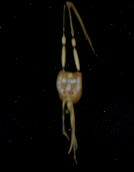
Knife
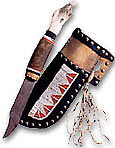
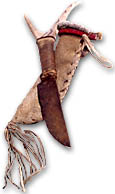
Lances

- Plains Indians were always grateful for the arrival of Spring. The first
soaking rain, considered to be a great cleanser of the earth, was
especially welcome. Impending rain or storms were foretold by the
behavior of birds, the spiritual patrollers of the skies. A messengers
for the spirits, they signaled coming events, including weather. The
raven, a bird of great wisdom, would talk to people, predicting events
and recommending courses of action. Swallows, with their
characteristic acrobatic flying agility, would appear when the
rainstorm had passed signaling that it was safe again The staff has a
hand-forged point and crown and, when thrust into the ground, it
served as a ceremonial tribute to new plant growth. The fringe near
the crown is tapered in the shape of wings. Leather wraps and ties,
rooster tail feathers and imitation raven feathers are used as
decoration.

Horse Dance Stick
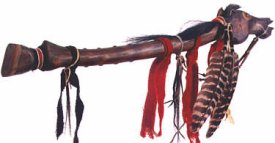
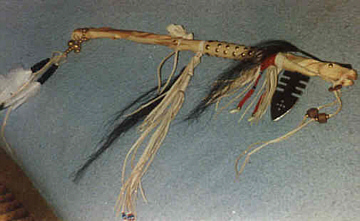
Tomahawk
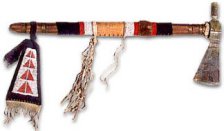
- The succesful hunt and dismemberment of the buffalo were followed by a dance to
celebrate and to honor the buffalo and the brave hunters. The Pipe Axe is the
epitome of such items. The hardwood handle is inlaid with four bands of brass
reflecting the four sacred directions. It is covered with blue trade cloth, leather, glass
beads, and buffalo hide. The drop end is covered with lazy stitch beadwork design of
the buffalo Vertabrae or buffalo track pattern. The head individually cast solid brass
with engraving.
War Shields
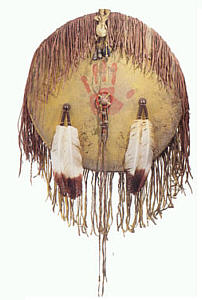
- The hand print is a signature of ownership and stature. Among Plains Indians, it
was reserved for those who had successfully provided for their people. In
peacetime the markings represent wisdom, responsibility and resourcefulness. At
war they mean strength, courage and cunning. Red stands for the earth and the
life-sustaining blood of the people. The dominant fringe represents the wind spirit
that surrounds us at all times. Braiding represents the unity of the people. The
shield protects the warrior in combat and symbolically protects his home. It
contains a personal bundle, medicine wheel, charms, deer toes to bring speed and
agility, imitation eagle feathers to empower the owner, and fringe of twisted
strands that represent whirlwinds, a power among wind spirits.
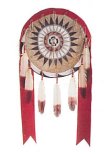
- In traditional Lakota culture, black came from the West and meant danger and
death. The Black War Bonnet warrior was the fiercest. He was feared by all; no one
crossed his path. Putting the black design on a shield or buffalo robe held back
death. It meant invulnerability. The white in this collection represents life.
Together, the two colors say in effect that this owner will not go into the next life
until the proper time. Attached to this shield are a quilled medicine wheel, red
trade cloth and seven imitation eagle coup feathers.with engraving.
Masks
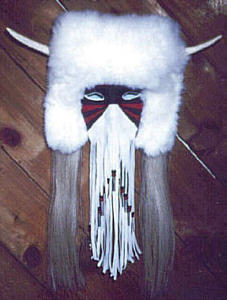
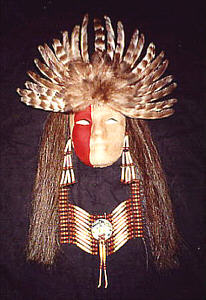
- This Handcrafted Native American Mask is a representation of a
warrior's spirit and courage. It is believed that the owner of the mask
will inherit the spirit and courage of the warrior.
Jacket Skirt
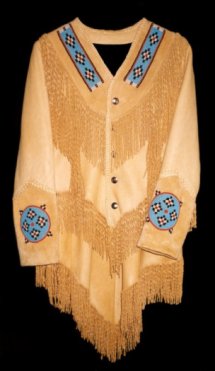
| Back | Home |
 Since 11/7/99
Since 11/7/99
Graphics was created by TigerEyes, WhiteTiger, or others with thier permission and
should not be taken with out written permission from them.
© 1999,2000,2001